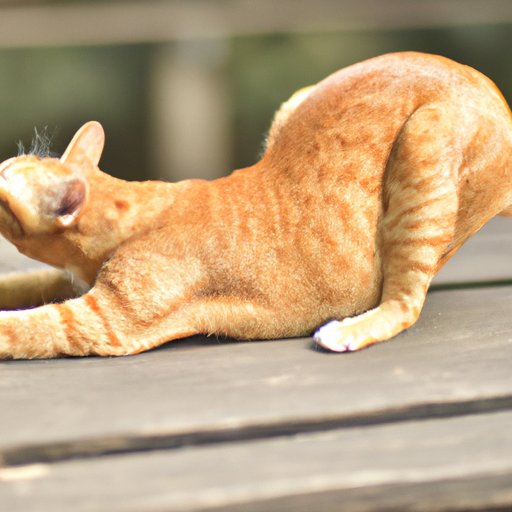I. Introduction
As a cat owner, you may have noticed your furry friend arching its back before. But what does this behavior mean? Understanding why cats arch their back is important for cat owners, as it can offer insight into your cat’s emotions and overall well-being. In this article, we will explore the science and significance behind a cat’s arched back, as well as offer tips for interpreting and responding to this behavior.
II. Understanding the Science Behind a Cat’s Arched Back
The anatomy of a cat’s spine plays a significant role in its arched back behavior. Cats have more vertebrae than humans, allowing for greater flexibility in their spine. Additionally, a cat’s muscles are built to support and move the spine, contributing to the arched back behavior. Finally, a cat’s nervous system plays a role in this behavior, as the arched back is often accompanied by a fluffed-up tail and dilated pupils, indicating fear or anxiety.
III. The Evolutionary Purpose of a Cat’s Arched Back
Cats have been domesticated for thousands of years, but their arched back behavior has roots in their wild ancestors. This behavior is a defensive posture for cats, intended to puff up their size and make them appear more intimidating to predators or threats. In addition to its defensive purposes, the arched back also allows cats to stretch and strengthen their muscles, contributing to their overall health and survival.
IV. What Your Cat’s Arched Back is Trying to Tell You
Cats communicate through body language, and their arched back is no exception. Understanding the context of the behavior can help you interpret what your cat is trying to communicate. For example, if your cat’s arched back is accompanied by a hissing or growling sound, it may be indicating aggression. Alternatively, if your cat is simply stretching and their arched back is accompanied by a relaxed tail and eyes, it may be a sign of contentment.
V. 5 Common Reasons Why Cats Arch Their Backs
While the arched back behavior can indicate a range of emotions, there are some common reasons why cats exhibit this behavior. Fear or anxiety is a common cause, as cats may feel threatened or uncomfortable and respond with a defensive posture. Similarly, aggression may be a reason for an arched back, particularly if your cat is feeling territorial. Playful behavior is also a possibility, as cats may arch their back and “pounce” on toys or other objects. Stretching is another common reason, as cats often use their arched back to stretch their spine and muscles. Finally, pain or discomfort may cause your cat to arch their back in an attempt to alleviate the discomfort.
VI. The Do’s and Don’ts of Handling a Cat with an Arched Back
When handling a cat with an arched back, it is important to proceed with caution. If your cat is exhibiting this behavior due to fear or anxiety, it may be best to give them space and allow them to calm down before attempting to interact with them. Similarly, if your cat is exhibiting signs of aggression, it is important to approach them carefully and avoid provoking them. Offering treats or toys can help distract an anxious cat and promote a positive response.
VII. How to Help Your Cat Feel More Comfortable When Arching Its Back
To promote a healthy, comfortable environment for your cat, it is important to provide plenty of exercise and play opportunities. This can help alleviate stress and anxiety and prevent aggressive behavior. Grooming and massage can also promote relaxation and positive emotions. Finally, ensuring a comfortable environment with plenty of safe hiding spaces can help your cat feel secure and content.
VIII. Conclusion
Understanding your cat’s behavior, including the arched back posture, is important for promoting their overall health and well-being. By recognizing the signs and interpreting the context, you can better understand your cat’s emotions and respond appropriately. Providing exercise, play, grooming, and a comfortable environment can help your cat feel content and relaxed, promoting a happy and healthy relationship between you and your furry friend.
